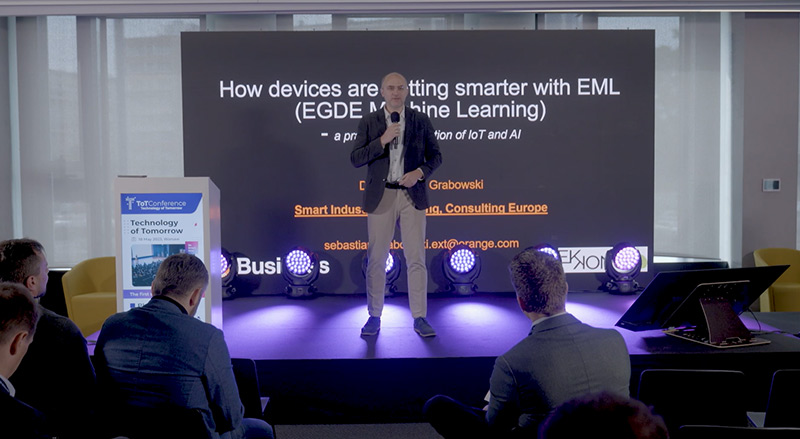There are approximately 22 billion devices connected to the Internet of Things (IoT), but the real number is likely far higher – with thousands more being added every day. This is according to Dr Sebastian Grabowski (Lead Enterprise Architect, Orange Business Services) who was speaking at the Technology of Tomorrow Conference in Warsaw, Poland.
Grabowski noted that entire industries – including construction and manufacturing – now rely on these IoT devices to operate effectively. This growth is set to explode even further in the coming years driven by Edge Machine Learning (EML), explained Grabowski.
IoT and Edge Machine Learning
Edge Machine Learning refers to the practice of deploying machine learning models directly on edge devices, such as sensors, cameras, smartphones, and other IoT devices, rather than relying solely on centralised cloud servers for data processing and analysis.
This approach leverages the computational power of these edge devices to process data locally, allowing for real-time decision-making and reducing the need for constant data transmission to the cloud.
By running machine learning algorithms at the edge, devices can autonomously make sense of the data they collect and respond to it quickly, even in remote or disconnected environments. This technology can be particularly valuable in situations where low latency, privacy, and bandwidth constraints are crucial, making it a key enabler for the future of IoT.
Edge Machine Learning greatly enhances the capabilities of IoT systems by addressing several critical challenges.
- First, it minimises latency, as data is processed on the edge device itself, leading to quicker responses and improved real-time decision-making.
- Second, it reduces the dependency on constant connectivity to cloud servers, which can be unreliable and expensive, making IoT systems more robust and efficient.
- Third, edge machine learning enhances privacy and security by allowing sensitive data to be processed locally, decreasing the risk of data breaches and ensuring compliance with data protection regulations.
- Finally, it helps manage the sheer volume of data generated by IoT devices by preprocessing and filtering data at the edge, sending only relevant information to the cloud, saving bandwidth and reducing operational costs.
In essence, edge machine learning is a crucial element in unleashing the full potential of IoT, making it more intelligent, efficient, and adaptable to a wide range of applications, from smart homes and cities to industrial automation and healthcare.
The BSV blockchain – the perfect fit
The BSV blockchain is the perfect technology match for IoT and machine learning as it is the only blockchain capable of collecting and storing vast amounts of data from IoT devices and scaling accordingly.
The BSV blockchain provides a secure and immutable ledger for recording and verifying IoT data. In IoT, data integrity and trust are crucial, as devices constantly generate and exchange data.
By utilising an immutable blockchain, IoT devices can ensure the integrity of their data, making it nearly impossible for malicious actors to alter or manipulate the information. This enhances the reliability and trustworthiness of the data, which is vital for various IoT applications, such as supply chain management, smart cities, and industrial automation.
Moreover, the BSV blockchain’s smart contract capabilities can automate and streamline various IoT processes, such as device authentication, data sharing, and billing, further reducing the need for intermediaries and minimising operational costs.
